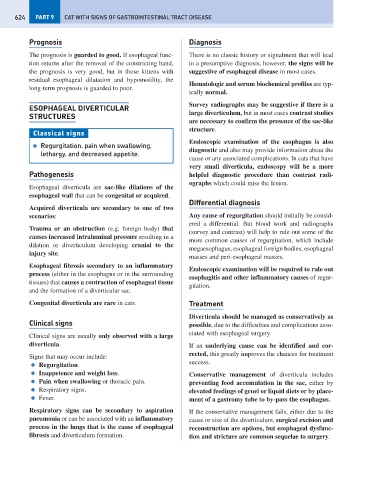Page 632 - Problem-Based Feline Medicine
P. 632
624 PART 9 CAT WITH SIGNS OF GASTROINTESTINAL TRACT DISEASE
Prognosis Diagnosis
The prognosis is guarded to good. If esophageal func- There is no classic history or signalment that will lead
tion returns after the removal of the constricting band, to a presumptive diagnosis, however, the signs will be
the prognosis is very good, but in those kittens with suggestive of esophageal disease in most cases.
residual esophageal dilatation and hypomotility, the
Hematologic and serum biochemical profiles are typ-
long-term prognosis is guarded to poor.
ically normal.
Survey radiographs may be suggestive if there is a
ESOPHAGEAL DIVERTICULAR
STRUCTURES large diverticulum, but in most cases contrast studies
are necessary to confirm the presence of the sac-like
structure.
Classical signs
Endoscopic examination of the esophagus is also
● Regurgitation, pain when swallowing,
diagnostic and also may provide information about the
lethargy, and decreased appetite.
cause or any associated complications. In cats that have
very small diverticula, endoscopy will be a more
Pathogenesis helpful diagnostic procedure than contrast radi-
ographs which could miss the lesion.
Esophageal diverticula are sac-like dilations of the
esophageal wall that can be congenital or acquired.
Differential diagnosis
Acquired diverticula are secondary to one of two
scenarios: Any cause of regurgitation should initially be consid-
ered a differential. But blood work and radiographs
Trauma or an obstruction (e.g. foreign body) that
(survey and contrast) will help to rule out some of the
causes increased intraluminal pressure resulting in a
more common causes of regurgitation, which include
dilation or diverticulum developing cranial to the
megaesophagus, esophageal foreign bodies, esophageal
injury site.
masses and peri-esophageal masses.
Esophageal fibrosis secondary to an inflammatory
Endoscopic examination will be required to rule out
process (either in the esophagus or in the surrounding
esophagitis and other inflammatory causes of regur-
tissues) that causes a contraction of esophageal tissue
gitation.
and the formation of a diverticular sac.
Congenital diverticula are rare in cats. Treatment
Diverticula should be managed as conservatively as
Clinical signs possible, due to the difficulties and complications asso-
ciated with esophageal surgery.
Clinical signs are usually only observed with a large
diverticula. If an underlying cause can be identified and cor-
rected, this greatly improves the chances for treatment
Signs that may occur include:
success.
● Regurgitation.
● Inappetence and weight loss. Conservative management of diverticula includes
● Pain when swallowing or thoracic pain. preventing food accumulation in the sac, either by
● Respiratory signs. elevated feedings of gruel or liquid diets or by place-
● Fever. ment of a gastromy tube to by-pass the esophagus.
Respiratory signs can be secondary to aspiration If the conservative management fails, either due to the
pneumonia or can be associated with an inflammatory cause or size of the diverticulum, surgical excision and
process in the lungs that is the cause of esophageal reconstruction are options, but esophageal dysfunc-
fibrosis and diverticulum formation. tion and stricture are common sequelae to surgery.

